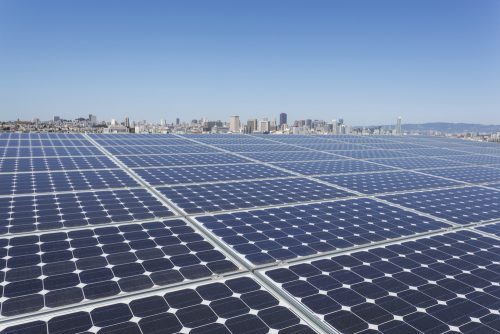
What Can the United States Learn from Germany’s Energiewende?
By serving as the global clean energy leader, the Germans are providing clear lessons for the rest of the world.
By Stephanie Wang
Note: Stephanie Wang was a participant ina July 9th TheEnergyCollective.com webinar,Exploring the Energiewende: Lessons from Germany’s Clean Energy Push.You can find an archive of that webinarhere. This piece originally ran onThe Energy Collective.
Germany has embarked on a bold effort to transition their energy system away from nuclear and fossil fuels towards clean, renewable energy sources. This long-term energy transition, known as theEnergiewendeoffers important lessons for U.S. energy policy.
First, it’s important to note that wholesale distributed generation (WDG), larger distributed solar systems that serve not only on-site but also local electricity demand, has been critical to the German energy transition. Germany’s solar market, which is now large enough tomeet half the country’s midday energy needs and roughly 5 percent of annual energy demand, is dominated by WDG. A full 80 percent of Germany’s solar capacity is on rooftops, highlighting thatdistributedrenewables – not larger utility-scale renewables – are powering Germany’s solar energy transformation. With more than 33 GW of installed solar, Germany has installed aboutfive times as much solar power than the United Statesdespite having Alaska’s level of sunshine.

Wholesale Distributed Generation (WDG) is the missing market segment in the United States
The United States boasts significantly stronger renewable resources than Germany, and growing the WDG market segment will put the nation on a path towards lasting energy independence. However, to effectively grow the WDG market segment, the nation must streamline lengthy and complex processes that currently stymie widespread development of WDG projects.

The U.S. has a much stronger solar resource than Germany, yet the cloudy European nation is bring solar energy online more cheaply
Germany has made great strides in streamlining the process of bringing clean local energy online through, making its solar market decidedly more efficient than the U.S. solar market. AForbesarticle declared that the installation costs of WDG systems in the U.S. could be reduced up to 50 percent simply by eliminating excessive paperwork. Research from Lawrence Berkeley National Laboratory suggests a streamlined market in California could bring rooftop solar online at a cost of 7-10 cents/kWh, depending on project size. Instead, the market in the U.S. remains prohibitively complex, and no solar project has ever delivered energy at such a low price.
Fortunately, forward-thinking utilities in the U.S. are already leading the charge by streamlining the development of cost-effective DG throughCLEAN Programs.
CLEAN Programs offer a standardized, fair contract for use between utilities and DG energy generators, and make interconnection processes transparent and efficient. As a result, CLEAN Programs have proven effective in bringing clean local energy online across the country.
The Clean Coalition actively supports the design and implementation of CLEAN Programs. OurLocal CLEAN Program Guideserves as a blueprint for developing a utility-specific CLEAN Program, while theCLEAN Resource Hubsimplifies the process of designing and implementing statewide CLEAN Programs.
Los Angeles, the nation’s second largest city, recently rolled out its CLEAN LA Solar Program to bring 100 megawatts (MW) of local solar online. Since opening the first 20 MW tranche in February, the Los Angeles Department of Water & Power (LADWP) has received applications totaling more than 115 MW – signaling strong demand for solar DG and correct pricing. To the east, Georgia Power – an investor-owned utility serving more than two million customers – is bringing 190 MW of cost-effective, local solar power online in its service territory by 2016 through a CLEAN Programs. Also this month, Long Island Power Authority (LIPA) expanded its Clean Solar Initiative from 50 MW to 150 MW, sending yet another signal that WDG is a readily available and cost-effective market segment.
The second lesson the U.S. can take from Germany is that achieving a high level of grid reliability is possible with significant renewable generation. As the world’s fourth largest economy and home to a heavy industrial base, Germany demands enormous amounts of reliable power. Distributed renewables have met this need, and Germany even set a global reliability record in 2011 with only 15.31 minutes of average downtime. Now that Germany is on track to meet its national target of 50 percent renewables by 2030, the country has embraced widespread adoption ofintelligent grid solutionsto maintain reliability. For example, the Germans are utilizing advanced inverters paired with solar PV to efficiently regulate voltage. Having captured lessons from the world’s best energy policies, the Clean Coalition recently laid outa roadmapfor the U.S. to achieve a timely and cost-effective modern energy system.
As with any rapid transformation, theEnergiewendehas not been without controversy and setbacks. Yet, by serving as the global clean energy leader, the Germans are providing clear lessons for the rest of the world. If the United States wants to save time, energy and money in its transition towards a cleaner, more reliable and more affordable power system, we must learn from theEnergiewende.
About the Author
Stephanie Wang is Regulatory Policy Director forthe Clean Coalition. Previously, Stephanie advised Pacific Environment on California energy policy, and practiced project finance and real estate law with Cox Castle & Nicholson in San Francisco and Fried Frank in New York. Stephanie received her JD and BA from the University of Michigan.
